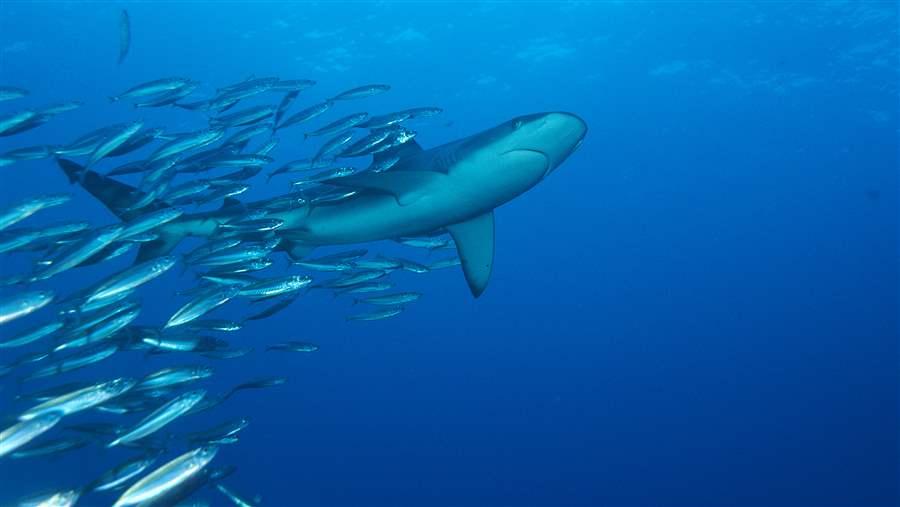Pew Praises New Zealand’s Announcement of Kermadecs Ocean Sanctuary
 Malcolm Francis
Malcolm FrancisWELLINGTON, New Zealand—The Pew Charitable Trusts applauds the government of New Zealand for its commitment, announced today, to create a 620,000-square-kilometre (239,383-square-mile) fully protected marine sanctuary in the Kermadec region. Located in the South Pacific about 1,000 kilometres (620 miles) northeast of New Zealand’s North Island, the Kermadecs are home to a wide array of species and serve as an important migratory pathway for marine mammals making seasonal journeys between tropical and cooler waters.
Today’s action expands a smaller marine reserve established in 1990, when the government prohibited all fishing and mineral extraction in an area extending 12 nautical miles from the coastline of each of the region’s six islands. The expansion will result in one of the largest fully protected areas of ocean in the world.
Pew’s Global Ocean Legacy campaign is working with local communities, governments and scientists to help create the world’s first generation of great parks in the sea. The goal is the creation of 15 of these parks in the sea by 2022—a fully protected marine sanctuary in the Kermadecs will be its seventh contribution. The project and its partners have helped to double the amount of fully protected ocean around the globe.
“The Kermadecs is a region of unique and sensitive underwater geography and marine biodiversity,” said Bronwen Golder, who manages Pew’s Global Ocean Legacy campaign in New Zealand. “We are just beginning to understand the abundance of life there, but we know that creating this marine sanctuary will safeguard rare habitats and species critical for healthy ecosystems throughout the South Pacific.”
Matt Rand, Global Ocean Legacy’s director, said the impact of the government’s action will be felt far beyond the region. “New Zealand will create the gold standard of conservation areas in the Kermadecs, preserving one of the few relatively unspoiled areas of ocean on Earth,” Rand said. “This commitment is an exciting step toward meeting global goals to safeguard at least 30 percent of the ocean through fully protected marine reserves.”
Remote, largely uninhabited and rarely visited, the Kermadec region is home to more than 50 underwater volcanoes that are part of the longest underwater volcanic arc on the planet. The region includes the Kermadec-Tonga trench, the deepest ocean trench in the Southern Hemisphere and the second-deepest on Earth. Large areas of the Kermadecs have yet to be explored because of the waters’ great depths. Still, more than 150 species of fish, 88 species of crustaceans, and 256 species of Bryozoans, or moss animals, have been identified there. As many as 35 species of whales and dolphins journey through the region, and up to 6 million seabirds breed on the islands each year. Three of the world’s seven species of sea turtles also can be found there.
Pew has worked since 2010 with many stakeholders who support protection of the Kermadecs’ waters, including the iwi (Maori) people, scientists, artists, businesses, community leaders, the Royal New Zealand Navy and nongovernmental organizations such as WWF-New Zealand and Forest & Bird. Initiatives in the effort have included the first Kermadec science symposium, which comprehensively profiled the geodiversity and biodiversity of the region, and numerous expeditions with scientists, artists, and youth leaders.
International recognition of the importance of large, fully protected marine reserves has been growing since the United States declared the Papahānaumokuākea Marine National Monument northwest of Hawaii nearly 10 years ago. Most recently, the British government announced plans in March to create the Pitcairn Islands Marine Reserve, which Pew proposed in partnership with the Pitcairn Island Council in 2013. Pew will participate on 5-6 October in the Our Ocean conference in Valparaíso, Chile, where additional commitments for marine protected areas may be made.
###
About The Pew Charitable Trusts
The Pew Charitable Trusts is driven by the power of knowledge to solve today’s most challenging problems. Learn more at www.pewtrusts.org.
About Global Ocean Legacy
Global Ocean Legacy is a partnership established in 2006 to promote the creation of marine reserves in the world’s oceans. Current partners include The Pew Charitable Trusts, Bloomberg Philanthropies, The Lyda Hill Foundation, Oak Foundation, The Robertson Foundation, The Tiffany & Co. Foundation, and the Waitt Foundation. Learn more at www.globaloceanlegacy.org.


This video is hosted by YouTube. In order to view it, you must consent to the use of “Marketing Cookies” by updating your preferences in the Cookie Settings link below. View on YouTube
This video is hosted by YouTube. In order to view it, you must consent to the use of “Marketing Cookies” by updating your preferences in the Cookie Settings link below. View on YouTube







